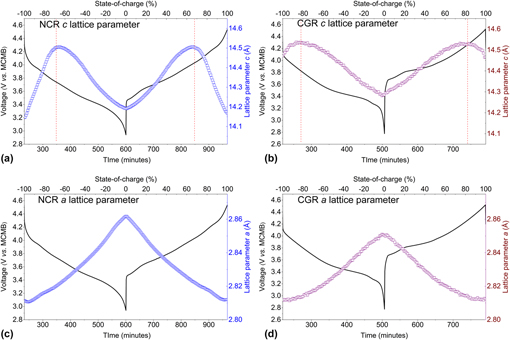Crossref Citations
This article has been cited by the following publications. This list is generated based on data provided by
Crossref.
Sharma, Neeraj
Pang, Wei Kong
Guo, Zaiping
and
Peterson, Vanessa K.
2015.
In Situ Powder Diffraction Studies of Electrode Materials in Rechargeable Batteries.
ChemSusChem,
Vol. 8,
Issue. 17,
p.
2826.
Nazer, N.S.
Yartys, V.A.
Azib, T.
Latroche, M.
Cuevas, F.
Forseth, S.
Vie, P.J.S.
Denys, R.V.
Sørby, M.H.
Hauback, B.C.
Arnberg, L.
and
Henry, P.F.
2016.
In operando neutron diffraction study of a commercial graphite/(Ni, Mn, Co) oxide-based multi-component lithium ion battery.
Journal of Power Sources,
Vol. 326,
Issue. ,
p.
93.
Chen, Chih-Jung
Pang, Wei Kong
Mori, Tatsuhiro
Peterson, Vanessa K.
Sharma, Neeraj
Lee, Po-Han
Wu, She-huang
Wang, Chun-Chieh
Song, Yen-Fang
and
Liu, Ru-Shi
2016.
The Origin of Capacity Fade in the Li2MnO3·LiMO2 (M = Li, Ni, Co, Mn) Microsphere Positive Electrode: An Operando Neutron Diffraction and Transmission X-ray Microscopy Study.
Journal of the American Chemical Society,
Vol. 138,
Issue. 28,
p.
8824.
Eremin, Roman A.
Zolotarev, Pavel N.
Ivanshina, Olga Yu.
and
Bobrikov, Ivan A.
2017.
Li(Ni,Co,Al)O2 Cathode Delithiation: A Combination of Topological Analysis, Density Functional Theory, Neutron Diffraction, and Machine Learning Techniques.
The Journal of Physical Chemistry C,
Vol. 121,
Issue. 51,
p.
28293.
Peterson, Vanessa K.
Auckett, Josie E.
and
Pang, Wei-Kong
2017.
Real-time powder diffraction studies of energy materials under non-equilibrium conditions.
IUCrJ,
Vol. 4,
Issue. 5,
p.
540.
Cao, Chunhui
Zhang, Jian
Xie, Xiaohua
and
Xia, Baojia
2017.
Composition, structure, and performance of Ni-based cathodes in lithium ion batteries.
Ionics,
Vol. 23,
Issue. 6,
p.
1337.
Sharma, N.
Yu, D.H.
Zhu, Y.
Wu, Y.
and
Peterson, V.K.
2017.
In operando neutron diffraction study of the temperature and current rate-dependent phase evolution of LiFePO4 in a commercial battery.
Journal of Power Sources,
Vol. 342,
Issue. ,
p.
562.
Bobrikov, I.A.
Samoylova, N.Yu.
Sumnikov, S.V.
Ivanshina, O.Yu.
Vasin, R.N.
Beskrovnyi, A.I.
and
Balagurov, A.M.
2017.
In-situ time-of-flight neutron diffraction study of the structure evolution of electrode materials in a commercial battery with LiNi0.8Co0.15Al0.05O2 cathode.
Journal of Power Sources,
Vol. 372,
Issue. ,
p.
74.
Lee, Po-Han
Wu, She-huang
Pang, Wei Kong
and
Peterson, Vanessa K.
2018.
The storage degradation of an 18650 commercial cell studied using neutron powder diffraction.
Journal of Power Sources,
Vol. 374,
Issue. ,
p.
31.
Eremin, Roman
Zolotarev, Pavel
Bobrikov, Ivan
Verkheev, A.
Aparin, A.
Bobrikov, I.
Chudoba, V.
and
Friesen, A.
2018.
Delithiated states of layered cathode materials: doping and dispersion interaction effects on the structure.
EPJ Web of Conferences,
Vol. 177,
Issue. ,
p.
02001.
Bobrikov, I.A.
Samoylova, N.Yu.
Ivanshina, O.Yu.
Vasin, R.N.
Sumnikov, S.V.
Kornieieva, K.A.
and
Balagurov, A.M.
2018.
Abnormal phase-separated state of Li Ni0.8Co0.15Al0.05O2 in the first charge: Effect of electrode compaction.
Electrochimica Acta,
Vol. 265,
Issue. ,
p.
726.
Vitoux, Laura
Reichardt, Martin
Sallard, Sébastien
Novák, Petr
Sheptyakov, Denis
and
Villevieille, Claire
2018.
A Cylindrical Cell for Operando Neutron Diffraction of Li-Ion Battery Electrode Materials.
Frontiers in Energy Research,
Vol. 6,
Issue. ,
Vadivel, Selvamani
Phattharasupakun, Nutthaphon
Wutthiprom, Juthaporn
duangdangchote, Salatan
and
Sawangphruk, Montree
2019.
High-Performance Li-Ion Batteries Using Nickel-Rich Lithium Nickel Cobalt Aluminium Oxide–Nanocarbon Core–Shell Cathode: In Operando X-ray Diffraction.
ACS Applied Materials & Interfaces,
Vol. 11,
Issue. 34,
p.
30719.
Goonetilleke, Damian
Stansby, Jennifer H.
and
Sharma, Neeraj
2019.
In situ studies: electrochemistry and scattering.
Current Opinion in Electrochemistry,
Vol. 15,
Issue. ,
p.
18.
Zhu, He
Huang, Yalan
Zhu, Hekang
Wang, Liguang
Lan, Si
Xia, Xinhui
and
Liu, Qi
2020.
In Situ Probing Multiple‐Scale Structures of Energy Materials for Li‐Ion Batteries.
Small Methods,
Vol. 4,
Issue. 6,
Liang, Gemeng
Didier, Christophe
Guo, Zaiping
Pang, Wei Kong
and
Peterson, Vanessa K.
2020.
Understanding Rechargeable Battery Function Using In Operando Neutron Powder Diffraction.
Advanced Materials,
Vol. 32,
Issue. 18,
Ding, Ruida
Huang, Yalan
Li, Guangxing
Liao, Qin
Wei, Tao
Liu, Yu
Huang, Yanjie
and
He, Hao
2020.
Carbon Anode Materials for Rechargeable Alkali Metal Ion Batteries and in-situ Characterization Techniques.
Frontiers in Chemistry,
Vol. 8,
Issue. ,
Sørensen, Daniel R.
Heere, Michael
Zhu, Jiangong
Darma, Mariyam S. D.
Zimnik, Samantha M.
Mühlbauer, Martin J.
Mereacre, Liuda
Baran, Volodymyr
Senyshyn, Anatoliy
Knapp, Michael
and
Ehrenberg, Helmut
2020.
Fatigue in High-Energy Commercial Li Batteries while Cycling at Standard Conditions: An In Situ Neutron Powder Diffraction Study.
ACS Applied Energy Materials,
Vol. 3,
Issue. 7,
p.
6611.
Nagarajan, Sudhan
Hwang, Sooyeon
Balasubramanian, Mahalingam
Thangavel, Naresh Kumar
and
Arava, Leela Mohana Reddy
2021.
Mixed Cationic and Anionic Redox in Ni and Co Free Chalcogen-Based Cathode Chemistry for Li-Ion Batteries.
Journal of the American Chemical Society,
Vol. 143,
Issue. 38,
p.
15732.
Feng, Junrun
Chen, Zhuo
Zhou, Weihua
and
Hao, Zhangxiang
2023.
Origin and characterization of the oxygen loss phenomenon in the layered oxide cathodes of Li-ion batteries.
Materials Horizons,
Vol. 10,
Issue. 11,
p.
4686.





